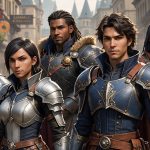Smartphones are no longer just communication tools; they are becoming central to managing our smart homes. With voice-activated appliances, you can simplify daily tasks, enhance convenience, and improve your home’s efficiency. Discover how to seamlessly integrate your smartphone with various smart devices, enabling intuitive control right at your fingertips. Explore tips and tricks that will empower you to make your home smarter, while saving time and energy for the things that truly matter. Get ready to unlock a new level of comfort and innovation in your living space.
Understanding Smart Home Voice Control
The advent of smart home voice control technology has revolutionised how we interact with our living spaces. By using voice activation, users can effortlessly manage their smart devices. Imagine walking into a room and simply saying, "Turn on the lights," and having them illuminate instantly. This convenience is one of the primary benefits of voice activation, providing hands-free control over various household functions.
Also read : Mastering Mobile Photography: Top Strategies for Capturing Stunning Images with Your Smartphone
Smart home voice control systems integrate seamlessly with a range of smart devices, from thermostats and lights to security cameras and entertainment systems. This integration allows for a cohesive and streamlined home automation experience. Popular devices that support voice activation include Amazon Echo, Google Home, and Apple HomePod, each offering distinct features tailored to different user preferences.
The benefits of using voice activation extend beyond convenience. It enhances accessibility, making it easier for individuals with mobility challenges to interact with their environment. Moreover, it contributes to energy efficiency by allowing precise control over device usage. As the market for smart home voice control continues to grow, we can expect even more innovative solutions that cater to the evolving needs of consumers.
In the same genre : Transform Your Space: Leverage Your Smartphone to Design an Intelligent Home Workout Zone
Setting Up Voice Activation with Your Smartphone
Setting up voice activation on your smartphone for smart home control can seem daunting, but with a few simple steps, you can transform your living space into a futuristic haven.
Preparing Your Smartphone for Smart Home Control
Begin by ensuring your smartphone is compatible with the smart home devices you intend to control. Check that your device's operating system is up-to-date to support the latest applications and features. This preparation is crucial for a seamless smart home configuration.
Downloading and Configuring Necessary Applications
Next, download the necessary apps that facilitate voice activation setup. Popular choices include Amazon Alexa, Google Assistant, and Apple HomeKit. Each app provides unique features, so select one that best suits your needs. Once downloaded, follow the in-app instructions to configure your smart home configuration.
Connecting Your Smartphone to Smart Home Devices
To connect your smartphone to your devices, ensure all devices are on the same Wi-Fi network. Use the app's smart home configuration feature to discover and add devices. Follow the step-by-step setup procedures provided by the app. If you encounter issues, check the app's troubleshooting section or consult online forums for solutions.
Compatible Smart Home Devices
Exploring the world of voice-activated technology opens up a plethora of options for those interested in enhancing their living spaces. A variety of smart home appliances are designed to integrate seamlessly with voice activation, making life more convenient and efficient.
Popular Voice-Activated Smart Home Devices
Some of the most popular smart home appliances include Amazon Echo, Google Nest, and Apple HomePod. These devices are renowned for their ability to control a wide array of smart home devices, such as thermostats, lights, and security systems, all through simple voice commands.
Compatibility with Smartphone Operating Systems
When considering compatible devices, it's crucial to ensure they work with your smartphone's operating system. Amazon Echo and Google Nest are compatible with both Android and iOS, providing flexibility regardless of your smartphone preference. Apple HomePod, however, is tailored specifically for iOS users, offering seamless integration with other Apple products.
Comparing Features Among Leading Brands
Each brand offers unique features:
- Amazon Echo: Known for its extensive smart home device compatibility and vast range of skills.
- Google Nest: Excels in natural language processing and integration with Google services.
- Apple HomePod: Offers superior audio quality and privacy features, ideal for Apple ecosystem users.
Voice Activation Platforms and Ecosystems
Navigating the world of voice activation platforms can be a thrilling journey into the realm of smart home ecosystems. Understanding the various digital assistants available is crucial for enhancing your home's technology.
Overview of Major Voice Platforms
Three major voice activation platforms dominate the market: Google Assistant, Alexa, and Siri. Each offers unique capabilities:
- Google Assistant stands out for its natural language processing and seamless integration with Google services.
- Alexa is renowned for its broad compatibility with numerous smart home devices and a vast array of skills.
- Siri excels in privacy features and is ideal for users immersed in the Apple ecosystem.
Integrating Multiple Devices Within an Ecosystem
Integrating devices within a smart home ecosystem involves ensuring compatibility across all gadgets. This process allows for a unified experience, where devices communicate and operate harmoniously. For instance, using digital assistants like Alexa can streamline control over a variety of devices, from lights to thermostats.
Choosing the Right Ecosystem for Your Needs
Selecting the right ecosystem depends on personal preferences and existing technology. Consider:
- Google Assistant for those who value natural interactions.
- Alexa for users seeking extensive device compatibility.
- Siri if privacy and Apple integration are priorities.
Advanced Voice Control Techniques
Advanced voice control techniques can elevate your smart home automation experience, offering personalised and efficient management of your devices. By creating routines and automation, you can enhance control over your environment. For example, a morning routine could involve a series of voice commands to adjust the thermostat, turn on lights, and play your favourite music. This not only simplifies daily tasks but also ensures a seamless start to your day.
Custom voice commands allow for a more tailored experience. By setting unique phrases, you can personalise interactions with your smart home, making it truly your own. Imagine saying, "Goodnight," and having all lights dimmed, doors locked, and the security system activated. These bespoke commands enhance convenience and security, reflecting your lifestyle preferences.
Integrating voice control with other smart technologies further enriches your home automation. By connecting voice assistants with devices like smart TVs, speakers, and even kitchen appliances, you create a cohesive ecosystem. This integration enables comprehensive control, allowing you to manage multiple devices with simple voice commands, thus streamlining your daily activities and boosting overall efficiency.
Troubleshooting Common Issues
Navigating smart home solutions can occasionally present challenges, but understanding common issues can streamline your experience.
Identifying and Resolving Connection Problems
Connection problems are a frequent hurdle. First, ensure all devices are on the same Wi-Fi network. If issues persist, restart your router and devices. Check for firmware updates as outdated software can cause disruptions. Moving devices closer to the router can also enhance connectivity. If a device remains unresponsive, a factory reset might be necessary.
Overcoming Voice Recognition Challenges
Voice recognition challenges can hinder seamless operation. Ensure your voice assistant is trained to recognise your voice by using the setup feature. Speak clearly and at a moderate pace. Background noise can interfere, so try to limit it when issuing commands. Regularly update the voice assistant app to improve recognition accuracy.
Maintaining Device Compatibility
Maintaining device compatibility is crucial for smooth operation. Always verify that new devices are compatible with your existing smart home system before purchasing. Regularly update all devices and apps to ensure they work harmoniously. If a device becomes incompatible, check for third-party solutions or consider upgrading to a newer model that supports your ecosystem.
User Reviews and Case Studies
Exploring user reviews and case studies provides valuable insights into the real-world effectiveness of smart home devices. These firsthand accounts highlight both the successes and challenges encountered by everyday users.
Compilation of User Experiences
Many users report that integrating voice activation into their homes has significantly enhanced convenience and accessibility. For instance, a user with mobility challenges shared how voice commands allowed them to control lights and thermostats without needing physical assistance. Such experiences underscore the transformative potential of smart technology.
Success Stories from Smart Home Users
Numerous success stories illustrate the seamless integration of smart home devices. One family managed to reduce their energy consumption by 30% using automated routines for lighting and heating. These stories demonstrate how strategic use of technology can lead to substantial benefits, both financially and environmentally.
Lessons Learned and Tips
Real-life applications offer valuable lessons. Users often recommend starting with a few key devices and gradually expanding your system. It's also advised to regularly update software to maintain compatibility and enhance functionality. These tips can help new users avoid common pitfalls and maximise their smart home experience.
FAQs About Voice-Activated Smart Home Control
Navigating the world of smart home technology can raise numerous user inquiries. Here, we address some of the most common smart home questions.
Addressing Common User Concerns
One frequent question is, "How secure is my smart home system?" The answer lies in robust security measures such as strong passwords and regular software updates. Additionally, using two-factor authentication can significantly enhance your system's security.
Clarifying Misconceptions About Smart Home Technology
A common misconception is that setting up a smart home is overly complex. However, with user-friendly apps and clear instructions, the process is more straightforward than many assume. Another myth is that voice-activated devices are always listening. In reality, they only activate when prompted by a specific wake word.
Providing Additional Resources for Further Learning
For those seeking more information, numerous online resources can deepen your understanding. Community forums like Reddit's smart home subreddit offer peer insights and solutions. Websites like Smart Home DB provide comprehensive guides and reviews. Exploring these resources can empower you to make informed decisions about your smart home journey.
Future Trends in Smart Home Voice Control
The landscape of smart home technology is rapidly evolving, with voice control innovations leading the charge. As we look to the future, several emerging technologies are set to transform how we interact with our homes.
Emerging Technologies in Voice Activation
One key development is the integration of artificial intelligence (AI) with voice control systems. AI enhances voice recognition capabilities, allowing for more nuanced and accurate interactions. This advancement means devices will better understand context and intent, offering a more personalised experience.
Predictions for the Evolution of Smart Home Systems
As smart home systems continue to evolve, we can expect increased interoperability among devices. This means that different brands and types of smart home technology will work together more seamlessly, creating a unified ecosystem. Additionally, advancements in natural language processing will make interactions more intuitive and human-like.
Potential Impact of AI on Smart Home Voice Control
The role of AI in voice control innovations cannot be understated. It enables predictive capabilities, where systems anticipate user needs based on habits and preferences. This could lead to homes that adjust settings automatically, enhancing comfort and efficiency without user intervention.











